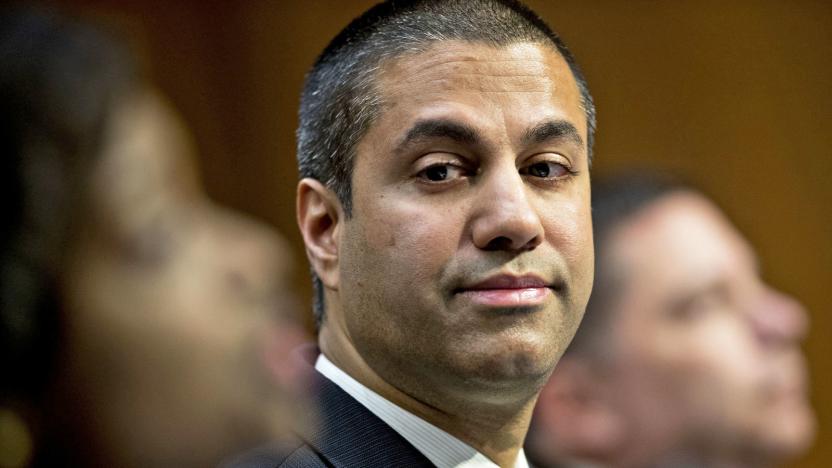BroadcastTv
Latest

FCC will vote on viewer-tracking broadcast standard this week
On Thursday, the FCC will vote on a new broadcast standard that stands to have a big impact on both consumers and broadcasters. Next Gen TV, also known as ATSC 3.0, will bring with it sharper images and video as well as the ability for TV broadcasters to get more detailed data about consumers' viewing habits. Rather than just broad demographics, those broadcasters will be able to collect viewing data similar to how cable providers do with set-top boxes and how websites track browsing history. That information could then be used to more specifically target ads to viewers. The FCC is expected to approve the new standard but many are voicing concern over privacy issues and lack of regulation.

Now Fox is live streaming its prime-time TV across the US
CBS All Access, NBC and Watch ABC were first to live streaming network TV on the internet, but this week Fox Now became the first broadcast network to stream its live TV nationwide. Unlike the CBS app, Fox is tying this "beta" access to the live streams to TV Everywhere authentications, which means cord cutters are not invited unless they snag a login from someone with cable TV (Disney-owned ABC and Comcast-owned NBC do the same). We'll have to wait and see if Fox ever opens things up for people to simply buy internet access, but for now its says 98 percent of pay TV subscribers should have access, representing some 96 million homes.

Aereo opens its streaming TV to Mac and Windows web browsers
If you'd wanted to watch Aereo's unique antenna-to-internet TV streaming until today, you had to tune in from an iOS device or Roku box. That's not a lot of choice for placeshifting, is it? A fresh update to the company's streaming service has widened the choices considerably for New Yorkers to include all the major browsers on Macs and Windows PCs. As long as you're using a recent version of Chrome, Firefox, Internet Explorer, Opera or Safari, you can catch up on Ion or Telemundo while you're checking email. About the only restrictions left are the continued lack of Android support and occasional lawsuits from traditionalist broadcasters.

Aereo doubles DVR space to 80 hours for early adopters
Were you so entranced by Aereo's approach to over-the-air TV broadcasting that you signed up even while the legal battles were just getting started? You're likely being rewarded for your trust. The company has confirmed with GigaOM that New Yorkers who subscribed in the "earliest days" will have their cloud DVR storage doubled to 80 hours -- no limited period, no extra charge. There should likewise be some improved tools for overseeing all that extra space in the near future, although just what that might entail is left to the imagination. We won't fret about it much: given the service's still-tentative existence, any upgrades are icing on the cake for customers.

Aereo avoids a preliminary injunction, keeps its antenna to internet TV service on the air for now
While the battle between Aereo, a service that brings OTA TV broadcasts to the internet, and the broadcasters that began suing it before it even launched continues, a judge ruled today against a request for a preliminary injunction to shut it down. Reuters reports that the basis for the decision is that while the broadcasters demonstrated they faced "irreparable harm", Aereo too faced harm from a potential shutdown, and the balance did not tip heavily enough in the broadcasters favor. So, for now the subscription feeds from those microantennas to NYC residents shelling out $12 a month will continue -- we'll wait see if the upstart streamer's streak continues.

FCC backs off talk of forcefully reclaiming spectrum from TV broadcasters
Rest easy, broadcasters: your hard-earned spectrum is safe, at least for the moment. The FCC's full-court press to round up additional spectrum for wireless broadband services had led it to suggest reclaiming some spectrum from broadcasters in recent months -- a move that would arguably make sense considering the ever-shrinking importance of over-the-air television and the availability of more efficient broadcast methods -- but was met with considerable resistance from the broadcast industry, ultimately leading it to back off the message this week. The Fed's director of scenario planning for its broadband task force has gone on record saying the commission had never seriously considered implementing such a plan, instead looking at "a scenario that establishes a voluntary marketplace mechanism so that broadcast TV stations have a choice in how they want to use their spectrum." In other words, sell it if you want, keep it if you want -- and in all likelihood, the FCC would be looking to repurpose any offloaded frequencies for broadband. Of course, this kind of plan could leave the country with a fragmented system of spectrum slots where individual stations have elected to sell part or all of their airwaves, not really an optimal solution when some estimates have us needing to clear several hundred additional megahertz to keep up with data demand over the next few years -- but it's a start.

Qualcomm FLO TV handheld in the works?
According to gdgt, Qualcomm -- which usually sticks to research, design, and the fabless chip game -- is fixin' to produce something called the Personal Television, for use with its FLO TV network. The handheld device is alleged to feature a capacitive touchscreen, a swipe and gesture-driven UI, 4GB of memory, built-in stereo speakers, and enough juice for five hours of video, fifteen hours of music, or three hundred stand-by hours. Currently, FLO TV is only available on a limited number of phones, from the likes of AT&T and Verizon in the States, although the company has said that they're planning on bringing it to other phones (via add-on peripherals) including the iPhone and WinMo devices. Can we offer one word of advice? You might want to go with a name besides "Personal Television." Really, it sounds so very 2006.

Qualcomm developing FLO TV accessories for iPhone OS 3.0, other smartphones
Qualcomm's fledgling FLO TV service might be on to something this time. President Bill Stone's announced plans to offer mobile broadcast to phones via add-on peripherals, including an iPhone 3.0-compatible antenna /chip accessory that's currently in the works, although without an estimated release window (Business Insider suggests it'll be ready sometime next year). The company's also looking into accessorizing Windows Mobile phones, either with a plug-in or some device that connects over Wi-Fi / Bluetooth. Seeing as the latest comScore statistics say less than one percent of all phone users watch mobile broadcast TV, which at the moment has to come built-in, this could prove to be a boon for the service -- assuming Q or the carriers can do something about those excessive pricing plans or fierce competition from Sling.[Via Electronista]


